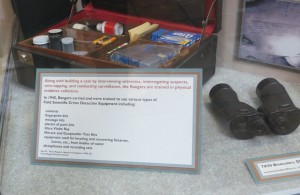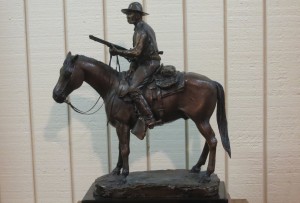If there are no paragraph separations in this article, double-click on the title and they will appear.
Last week in “Who are the Texas Rangers?” I chatted about a bit of the Texas Rangers’ colorful history. But, what do they do? Are they really like “Walker, Texas Ranger,” the old TV show? Or the “Lone Ranger” of TV and movie fame? Well…yes and no. Most Rangers do not go around karate chopping the suspects or jumping from car to car on the roofs of trains barreling down the railroad tracks. That makes for great TV, but not for smart investigation and apprehension of the criminal types. Setting aside the flamboyance of the entertainment characters, here is what the Rangers’ area of investigative responsibility might include:
- burglary rings
- bank robberies
- fraud
- sexual assault
- kidnapping
- murder
- jail suicide
- cold cases
- serial killers investigations
- public corruption
- officer involved shootings
- border security operations
- apprehending escaped/wanted suspects and convicted criminals
Basically, they are the primary criminal investigative arm of the Department of Public Safety in Texas and serve in whatever capacity will help the local law enforcement agencies. They are ‘subject to call’ at any hour of the night or day, in the counties to which they are assigned. When needed, they also assist in counties outside their own jurisdiction. Texas Rangers are a bit like a State Bureau of Investigation that operates in other States. Think CSI, without the TV glitz or instantaneous results.
These guys do it all, from the beginning to the end of a case, selecting and collecting evidence, photographing the scene, conducting the investigation, searching for, capturing and questioning the suspects, filing the reports, and more.
The Texas Rangers out in the field have to be able to handle every type of case that comes their way. And, I say “comes their way” because they are invited by local law enforcement to assist and/or take over certain cases. If a small town Police Chief normally has nothing more than drunks carousing on a Saturday night to deal with, and a bank robbery occurs or a murder is committed, he/she is likely to call the area Texas Ranger to help out with evidence collection and/or investigation/questioning.
With that in mind, a Ranger maintains a well-supplied trunk load of gear, including tire impression kits as well as chemical testing and other kits, so that he’s ready for whatever he’s asked to do.
If the Police Chief or Sheriff has never had experience with the particular case at hand (serial killers, kidnappings, etc.) he/she may ask the Texas Ranger to take the lead on the case – and then the local law enforcement follows the Ranger’s direction. Local people handle the press and dealing with the public. The smart Rangers work hard at establishing a good working relationship with the cops and sheriffs in their territory. Building trust is key.
Technical Training:
The Texas Rangers have ongoing training. They are required to take 30 hours of training a year, sometimes in firearms, but in any area that needs to be addressed. The hours might be spent on:
- CSI – technical information
- Murder Investigation
- Criminal Profiling
When blood spatter analysis was being looked at as a viable method of crime scene investigation, the Rangers trained in that. Other areas, such as better ways to collect fingerprints, etc. also became part of the preparation. You can’t be an expert in everything, but they have to know where to find the experts.
Firearms training:
As I mentioned in the last post, I’m really a stand-and-shoot guy and would never be able to shoot a rifle while on a moving horse. I was happy to discover that firearms training starts with bull’s-eye shooting for a Ranger. I could at least handle side-by-side with them at that stage. Lol They start with stand-and-shoot, then over the range of their careers, they learn to move-and-shoot, with a moving target and a moving shooter. They become proficient with handguns as well as long guns.
Sometimes, special circumstances require more than just one Ranger to show up. For those times, there is the Special Operations Group. Under that umbrella?
- Special Weapons and Tactics
- Regional Special Response Teams
- Crisis Negotiation Units
- Explosive Ordnance Disposal
Famous Cases:
I recently had the privilege of meeting with Texas Ranger, Ret., Richard (Dick) Johnson, who chatted with me about a few of the cases he worked on.
A nurse in small town Nocona, Texas, likely killed 23 people under her care. From December 11, 2000, to February 18, 2001, Vickie Dawn Jackson murdered ten patients at Nocona General Hospital, probably another ten, and attempted to murder five more. She was not a mercy killer trying to help patients who were terminally ill or in terrible pain. Prior to her killing the patients, she had appeared to be a sweet, caring nurse. She knew most of the victims personally. She injected the patients with mivacurium chloride, a muscle relaxant used in surgeries. The only murder that seems to have had any clear motive behind it was the last one, when she injected the grandfather of her ex-husband.
Sergeant Johnson collected the evidence, including exhuming the bodies, and stayed with the case until it was concluded. It took six months to do the collection and investigation and he had to handle all of his other cases and anything else that came up during that time. It was grisly work, not like the glamorous stuff we see on TV.
Another case of his involved chasing four Texas capital murder convicts into Oklahoma. The FBI was called in, and then they deferred to Dick Johnson. It took 160 hours over ten days, but Dick and a team caught the guys.
During a kidnapping case, he was in ‘hot pursuit’ of the kidnapper and had to cross the Red River (the border between Oklahoma and Texas) but he was not about to wait for permission to enter the next jurisdiction and lose the suspect and the victim. So, he radioed the dispatcher and told her he was about to cross the Red River. He figured he could deal with the investigation later. Thanks to his clear thinking, the suspect was caught.
Ranger Johnson had five counties under his responsibility during his time in North Texas. Those counties are miles wide and include everything from small towns to good-sized cities to ranches and mesquite trees. If he got a call in the middle of the night telling him that shots had been fired and a crook was on the loose, he might have asked, “How soon do you need me?” and “Do you need horses or dogs for the manhunt?”
The man had an amazing career, to be sure. He enjoyed working in the trenches, and is one of the guys that preferred the “Mud, blood, and the beer,” rather than the glamor and glory attached to being part of one of the most respected law enforcement outfits in the world.
Many thanks to Texas Ranger, Ret., Dick Johnson for generously sharing his experiences and extensive knowledge of the Texas Rangers organization. Any errors in fact are mine, not his.
For more information about the ‘Angel of Death’ please see:
http://www.texasmonthly.com/story/angel-death
Next week: The Modern Texas Ranger and how to become one.
*Photos by Patti Phillips





Wow such an interesting article as ever. I had no idea of just what they did. The piece about the Nurse is interesting and reminds me of the case we had here recently – I think the nurse (male) was from the Philippines – who doctored the drips of patients in hospital. Possibly 20 or more, some old some not that ill – with insulin. Has just been sentenced. Also we had a case some years back whereby a GP (General Practitioner) who had been a local doctor for decades, was sentenced having managed to bump off his elderly patients over 30+ years. Many died in his surgery, some after home visits. Most managed to leave him their money. He was sentenced for deaths of about 20+ patients but in actual fact he most likely killed over 200! Trusted and loved by his patients, pillar of the community. Hanged himself in prison soon after his sentence began. They could not prosecute all the murders he was suspected of as it would have not been practical. A local woman whose mother died suddenly after a home visit drew attention to the murders. Those dying in his surgery were also a red flag ignored – hardly ever does someone die in a surgery. He wrote the death certificates for decades so there was no-one to answer to. All this has been changed now so it should never happen again. His name was Dr Harold Shipman if you want to look it up. Jane x
Thanks so much for sharing the Shipman case with us, Jane. I’m definitely looking it up!
I’m definitely looking it up!